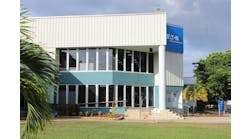More sustainable machines and the processes they drive will be a key part of many industrial strategies, and they are already influencing machine design and operation. In many cases, these same practices are already used in the name of efficiency, cost savings and profitability.
Sustainability will soon be an equal player in that arena, leaning into the efficiencies industry has already capitalized on and bringing in new opportunities.
More flexible and open machine design will support the data infrastructure and accumulation needed for more efficiency gains. Likewise, technology advances in batteries, semiconductor materials, electric control, pneumatic actuation and design advances for more flexible and open communication and data sharing will provide the next level of efficiency standards.
Lithium batteries for mobile power
When a pet-food manufacturer wanted a more efficient method for sampling products in various parts of the plant, it went to Gray Solutions, a system integrator, based in Lexington, Kentucky. The legacy solution was a pneumatic carrier tube system, but Gray Solutions recommended an autonomous mobile robot to move materials to and from production lines with operators. “This solution was much cheaper overall but also had a significant impact on energy usage,” says Greg Powers, vice president of cool stuff at Gray Solutions.
AMRs and automated guided vehicles (AGVs) use lithium batteries, which are more efficient than motors to run conveyor belts. “Rechargeable batteries are much more efficient than long conveyors with many motors,” he adds. The AMR solution was also cheaper overall than replacing the old system of pneumatic tubing and vacuum motors.
Overall, Gray Solutions has many customers asking about energy usage monitoring for their automation projects, including the sensors and devices used to capture the needed data. “In addition, since we are heavily involved in building manufacturing facilities, reduction in emissions and greenhouse gases is always a consideration in adopting these technologies or processes for greenfields,” Powers says.
Wide-bandgap materials in semiconductors
Silicon has been dominant in semiconductors for many years but is reaching its performance limits. New materials for semiconductors have the potential to make significant impacts on energy consumption. Wide-bandgap (WBG) semiconductor materials can make electric components smaller, faster and more efficient than silicon-based counterparts.
“New technologies, such as wide-bandgap technologies—silicon carbide (SiC) and gallium nitride (GaN)—apply to power conversion and inversion, and motor drives and control,” says Alex Wood, global senior marketing director at Avnet Embedded. “Power conversion and inversion involves high-voltage switching. DC and ac motors require conversion and inversion. The speed of switching and how easily these devices can be controlled directly impacts overall efficiency and losses.” WBG materials switch faster and with fewer losses than incumbent solutions, such as insulated-gate bipolar transistors (IGBTs) and metal-oxide-semiconductor field-effect transistors (MOSFETs), explains Wood. “Although WBG devices are currently more expensive than their IGBT and MOSFET counterparts, the price difference is moving in the right direction, while the gains in terms of energy efficiency are already here,” he says.
In industrial machine design, Wood says that moving motor drives toward the use of WBG is probably slower than in new markets, such as electric vehicles (EVs) and EV charging, where WBGs are used for power conversion and inversion. However, he also says that the leading semiconductor vendors in this area have a very clear objective to enable the industrial market to benefit from the gains offered by WBG.
Tight, precise control
Jim Larsen, focus industry manager of food and beverage at Burkert USA says both large and small companies are increasingly investing in monitoring and traceability technology for resources like energy, water and compressed air.
“Further, companies are taking a serious look at equipment that can deliver precise control,” he says. “The motivation here is there is efficiency and resource savings in precision. Devices that control to a tighter tolerance utilize fewer utilities. Additionally, devices that simply take less energy to operate are obvious targets.”
More compact systems and components are also a part of sustainability. Block-style manifolds and complex piping flow paths allow for more accurate and efficient control of applications like process heating and cooling, clean-in-place (CIP) cycles and faster switching between media, Larsen says. “There is a blended approach to using electric control and pneumatic actuation in the same process control loop, based on which is more effective to provide the desired results,” he explains. “Precise control of critical process systems is a means to optimize system efficiency. For example, when looking to control a heating or cooling process, the faster that system can be stabilized and the more tightly it can be maintained, the more efficient it is overall. When precision capability is combined with lower energy consumption by the devices themselves, there is a direct and very desirable impact to not only sustainability initiatives, but return on investment/total cost of ownership as well.”
Electric vs. pneumatic
“More critical thought is given to engineering choices, starting with the decision whether to go primarily with electric or pneumatic automation for the machine,” says Frank Langro, director of product market management, pneumatic automation at Festo. “This decision comes down to the application as well as cost. When the choice is to use pneumatics, OEMs are more interested today in optimum sizing than they have in the past, as proper sizing not only saves energy, it also saves on cost of components and contributes to overall equipment effectiveness.” OEMs use Festo pneumatic sizing tools much more frequently, says Langro. “This is in contrast to engineers selecting a valve based on the cylinder’s port size. Now it is sizing for optimum performance,” he explains.
The automotive industry has been trying to move away from pneumatics and go all-electric with their production lines for years, Langro says. “It was a result of energy costs, the cost of generating pneumatic compressed air was seen as more expensive than running electric for electric servo drives and steppers,” he adds. However, certain applications demand the forces needed from pneumatics, or space constraints demand compressed air.
The packaging industry, Langro says, is also embracing electric where possible, with many machine builders producing all-electric versions of, for example, a case packer or box erector. There also may be instances where machines require electric and pneumatic power, because of space or cost concerns. “We see both approaches being used in the market,” Langro says.
Typically, the component cost for a new electric system will be more expensive than pneumatic. “Pneumatic is a low-cost technology. But there is an overhead that goes with pneumatics in terms of having a compressed air system in your facility,” Langro says. Likewise, in a brand-new facility with no installed infrastructure, the pneumatic system would cost more from the ground up. “If you’re going into an existing facility that already has a pneumatic system and infrastructure in place, there’s minimal add-on cost,” Langro says.
Soft starters and VFDs
“OEMs are increasingly more conscious of energy consumption than ever before,” says Jason Demicoli, product line manager, switches, Americas, at Carlo Gavazzi. “We started getting more requests for products that do not just switch the loads on/off but also help in reducing energy consumption.” Variable-frequency drives (VFDs) are one solution, when used properly, that can reduce energy costs in motor-control applications.
“Soft starters are also a technology that may result in energy savings by reducing peak demand from motor loads,” Demicoli says. In heat-pump applications, this can require less over-sizing of generators and off-grid inverters.
“In applications where the motors run at full speed, the soft starter is more efficient than a VFD as it has lower losses during operation,” Demicoli adds.
Control flexibility
Flexible and reconfigurable machines support the scale-up of new operations and help facilities more easily upgrade legacy equipment to match market needs. “Controls technologies can support sustainability efforts in several ways,” says Patrick Varley, product marketing manager at Mitsubishi Electric. “First, as they have become more versatile and easier to use, they help make sure that equipment remains serviceable, optimizing uptime. In addition, it is easier to repurpose controllers and monitoring systems to suit different projects as companies progress forward in their digitalization and sustainability roadmaps.”
As with most manufacturing technologies, increasing the flexibility to accommodate future automation requirements is important, adds Varley. This enables users to add to I/O to control more machines or utilize different communications protocols, which may be required if a new device needs to be added to the machine, he stresses.
Machine designs that offer greater availability to monitoring capabilities, through integration with supervisory control and data acquisition (SCADA) systems, support the flexibility needed to meet sustainability and profitability and operation standards, Varley adds.
Open architecture and shared data
Upgrading legacy systems with monitoring capabilities to support more efficient operations will be a big challenge for many older facilities, but they can start by establishing open network architecture that will help future integration. Clean data collection and modeling will also be a key foundation to optimizing for energy efficiency.
“Machine builders are also developing energy-ready machines for seamless integration into end users' energy management systems,” says Corinne Pellish, sustainability partnership and program manager at Rockwell Automation. “These machines are engineered to connect with nearby equipment and operate in an energy-efficient manner. A crucial design approach involves establishing a network infrastructure using an open, unified network architecture. Additionally, to facilitate seamless integration, manufacturers are designing an object-based data model that enables shared data across the system, library management at the automation layer and automatic discovery by the information layer. In terms of energy-ready machines, OEMs can create the common data model around water, air, gas, electric and steam data.”





